How to Study:
A Brief Guide |
|
Last Update: 25 October 2005
Note:  or
or  material is highlighted
material is highlighted
|
If you are reading a printed version of this, you might be interested in
the Web version, at
http://www.cse.buffalo.edu/~rapaport/howtostudy.html
which has numerous links to other helpful Web sites (indicated in some
printed versions by underlined phrases).
OUTLINE and INDEX:
- Introduction
-
Manage your time
-
Take notes in class & rewrite them at home
- Study hard subjects first & study in a quiet place
-
Read texts actively & slowly, before & after class
- Do your homework
-
Study for exams
- Take Exams
-
 Do research & write essays
Do research & write essays
-
Do I really have to do all this?
- Are there other websites that give study hints?

Everyone has a different "learning style".
(A good introduction to the topic of learning styles is Claxton &
Murrell 1987.
For
more on different
learning styles,
see
Keirsey Temperament and Character Web Site,
William
Perry's Scheme of Intellectual and Ethical
Development,
Holland 1966,
Kolb 1984,
Sternberg 1999.)
Consequently, everyone has a different "studying
style". But the way that you are studying right now might not be the best for
you. How would you know? Easy: If your grades aren't what you'd like
them to be, then you probably need to change how you study!
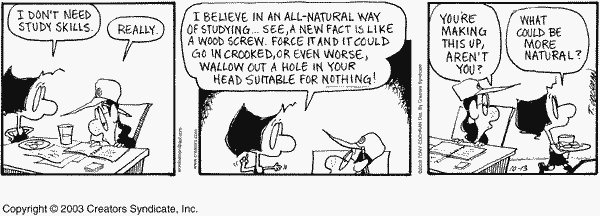
I am going to give you some suggestions on how to study efficiently. They
worked for me when I was in high school, college, and graduate school.
Not only that, but they worked equally well for me in humanities courses
(like philosophy and literature) and in science courses (like math and
computer science). But, given that everyone's learning style is
different, some of my suggestions may not work for you, at least not
without some individual modifications. Nevertheless, I urge you to
try them. Most successful students use them (or some slight
variation of them).
Please feel free to send me
suggestions for studying that worked for you. I will try to include
them in further versions of this guide.

School is a full-time job. And managing your time is important.
How much time should you devote to studying? A recent
survey
in the Chronicle of Higher Education suggested that students
are not studying enough. So, how much is enough? If you assume that
your education is a full-time job, then you should spend about 40
hours/week on it. Figure that 1 academic credit equals about 1
hour. So, if you're taking 15 credits, then you're spending about 15
hours in class. Subtracting that from 40 gives you 25 hours that you
should be spending studying at home (or in the library).
You should spread that out over the week. Suppose you decide to study
Sunday through Thursday evenings, taking Fridays and Saturdays off (from
studying, that is). Dividing that 25 hours by those 5 days gives you 5
hours of studying per night. If you think that's too much, then plan on
studying in the afternoons, too, or some of Saturday.
The above are just rules of thumb. If you're taking a 3-credit
independent-study course, but you meet with your instructor only 1 hour/week,
then you should add the extra 2 hours to your at-home study time. If
you're working to earn some money, you should subtract your work hours
from your free time, not from your study time! (If you don't
want to do that, then you should consider quitting your job or reducing
your course load.)
If that still seems like a lot, consider the difference between
high-school courses and college courses. The typical high-school course
meets every day, for about 5 hours/week. But the typical college course
meets only about 3 hours/week, yet is supposed to be more intensive than
its high-school counterpart. That's because in college you're expected
to put more of your own time into studying.
Set yourself a grade goal. If you don't meet it, cut down on
non-school activities. (If you can't, because you're working for a
living, then consider dropping down to part-time schooling.)
For some tips on managing your time during exams,
see below.
For some websites on time management, take a look at:
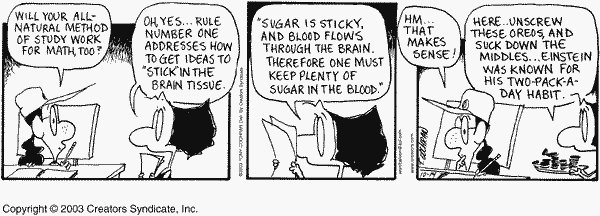
- Take Notes
- Take Complete Notes
- Use Abbreviations
- Neatness Doesn't Count
- Ask Questions & Make Comments
- Copy Your Notes at Home
- Don't Take Notes on a Computer
- Don't Rely on the Instructor's Lecture Notes
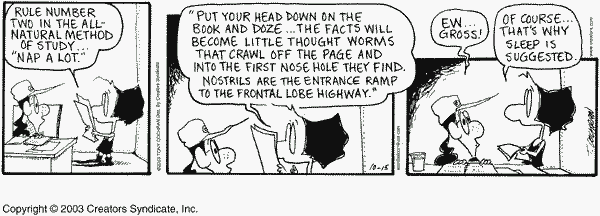
Good studying at home begins with good notes taken in class. Just as
everyone has a different learning style, different teachers have different
teaching styles (and often these clash with the students' learning
styles!): Some teachers lecture, some lead discussions, some
"facilitate" individual work (as in a lab), etc. Consequently,
different classroom settings will require different note-taking
techniques.
But the suggestions here are general enough to work in most situations.
The key idea of taking good notes in class is to
write down as much as possible.
There are several reasons to take notes that are as complete as possible:
- It will force you to pay attention to what's going on in class.
- It will keep you awake (!)
- There will be less that you'll have to remember.
Should you concentrate on taking notes or should you concentrate on
understanding what you are learning? Paradoxically, I'd err on the
side of taking notes, not understanding! Understanding can come later,
when you review your notes.
But if you have incomplete notes, it will be
hard for you to learn what you didn't take notes on.
Taking complete notes will require you to write fairly quickly and, as a
consequence, to use abbreviations. Here are some that I use (many of
which I stole from other students and teachers), to give you an idea of
how you can abbreviate.
If you send text messages on your cell phone, then you know the sort of
abbreviations I'm talking about. Use them when you take notes in
class!
| ABBREVIATION | MEANING |
| betw | between |
| ccpt | concept |
| cd | could |
| compn | computation |
| compnl | computational |
| comp | complete |
| dn | description |
| fn | function |
| h. | human |
...g
(e.g., contg) | ...ing
(continuing) |
...l
(e.g., compnl) | ...al
(computational) |
| lg | language |
| mn | mean |
| mng | meaning |
...n
(e.g., abbrvn) | ...tion
(abbreviation) |
| NB: | note/note well/nota bene |
| pn | proposition |
| prop | property |
| re | about (from Latin) |
| reln | relation |
| qn | question |
...r
(e.g., compr) | ...er
(computer) |
| shd | should |
| s.t. | something/sometimes
(context should make it clear which you mean) |
| stmt | statement |
| thot | thought |
| w/ | with |
| w/o | without |
| wd | would |
| wh | which |
| & | and |
| v | or (this is a symbol from logic) |
| ¬ | not/negation sign
(this is a symbol from logic) |
 | possible/possibly
(this is a symbol from logic) |
 | must/necessary/necessarily
(this is a symbol from logic) |
 | all/for all/every
(this is a symbol from logic) |
 | some/there is/there are/there exists
(this is a symbol from logic) |
A related idea is based on a system of shorthand called Speedwriting: There used to be
ads in the New York City subway system that read something like this:
if u cn rd ths, u cn lrn spdwrtg
The key idea in abbreviating is to use abbreviations that will make sense
to you. You can put an abbreviation key in the margin of your
notebook for any abbreviations that you make up on the spot.
Yet another key idea of note-taking is that you don't have to be
neat; you only have to be legible enough to be able to read
your notes a few hours (or, at most, a few days) later. The reason for
this
will become clear later.
If you have a question or something comes to mind as you're taking notes,
you have two choices: You can contribute to the class discussion by
asking your question or making your comment. Or you can jot your question
or comment down in your notes. I suggest always doing the latter, but
also doing the former as often as possible. One reason that you should
always put your question or comment in your notes is so that you won't
forget it; you can then always bring it up later, either in class or
one-on-one with the teacher or a fellow student.
Another reason, of course, is that if you do bring it up in class,
it should thereby become part of the day's class notes! One technique
that I use to be able to distinguish my own questions or comments from the
rest of the notes is to put them in the margin and/or to surround them
with big, bold square brackets
[like this.]
By the way, if you have a question, especially if you need clarification
of something that the teacher said or wrote (possibly because it was
inaudible or illegible), ask it! Do not be embarrassed about
asking it! I can guarantee you that there will be at least one other
student in the class (and often many more) who will be extremely grateful
to you for having asked the very same question that they were too
embarrassed to ask, and they will come to view you as wise and brave for
having asked it. (So will the teacher!)
Notice that this section is titled "Take Notes in Class & Rewrite
Them at
Home"; the title was not "Take Notes in Class & Study Them
at Home". Of course you should study your class notes at home; but just
(re-)reading them is too passive. One of the themes of this guide
is that studying must be active. It is all too easy when
just reading passively to have your mind wander or even to fall
asleep:
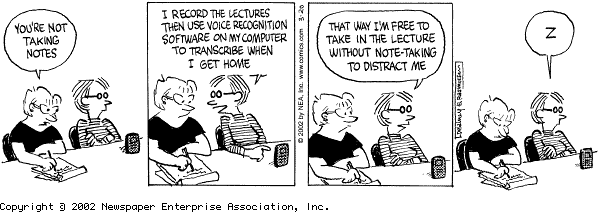
Moreover, notes are often incomplete or sketchy; just reading
such notes won't help. And a few days or months after you take them, they
may very well be illegible or incomprehensible.
Finally, if you don't do something active with your notes, you run the
risks of having unorganized notes or of misplacing them.
What I suggest is that you study your notes by re-writing them.
For each class, buy a separate notebook from the one you take your notes in.
I recommend a "composition" or spiral notebook, not a looseleaf
notebook, for your "permanent" (i.e., re-written) notes. Then, as soon as
possible after class (preferably that evening or the next), copy your
notes into your permanent notebook.
The main idea behind re-writing your "raw" class notes (besides making
them more legible and organized) is that the very act of copying them is
one of the best ways of studying them! Further study of your class notes
can then be done from these "cooked" ones that are neater, more legible,
more organized, and more complete. I will suggest ways to do this later.
Use this opportunity to fill in gaps
from your memory while they are still fresh in mind. You may find that
you have questions, perhaps something you missed or don't understand, or
even a "substantive" question. If so, good! Make a note of your
question and ask it in class next time!
Use this opportunity to
(re-)organize your notes in a more logical or coherent fashion. You could
write your permanent notes in an outline form if that seems suitable: You
don't have to follow any "official" or formal outlining style (e.g.,
using the I.A.1.(a)(i) format or the (sometimes silly) rule that there
must always be at least two subsections, never just one) -- after all,
these are your notes. Personally, I like to number main ideas (and
separate them with a line), using
an "indented bullet" style for details:
1. Main idea 1
- detail 1
- detail 2
- further detail 2.1
- detail 3
- further detail 3.1
- further detail 3.2
2. Main idea 2
3. Main idea 3
etc.
By the way, I do not recommend taking class notes on a laptop
computer. Certainly you should not do this unless you are a very
good typist and have "compiled" your word-processing or text-editing
program into your fingertips. (In any case, typing can be very noisy and
disturbing to your fellow students!) Also, typing class
notes into a computer file can be inconsistent with my recommendation to
re-write your class notes.
Of course, you can edit your computer
file later, but editing is not the same as copying,
and I am recommending
copying as a means to studying (for one thing, it forces you to (re-)read
all your notes). Of course, you can copy your raw notes into a
neater computer file; this may be a matter of taste, but I find that I
have a firmer grasp of what I write if I handwrite it than if I type it.
(As Usama Fayyad of
Microsoft Research has said,
computers are "great at bookkeeping
but not yet great at recording impromptu
ideas, thoughts, feelings. For that, paper
is still far superior. You can hold it, fold
it, put it in your pocket, look at it again
later when it's convenient" (as quoted in
Swerdlow 1999: 130).)
Some instructors provide their own set of lecture notes, often on the
Web or in PowerPoint (or some other format). These can be useful,
but you should not rely on them. If all you do with them is
print them out, maybe read them once, and save them, they are useless,
because you are using them passively. You need to treat them
just as you would with your own lecture notes: Re-write them! Better
yet: Use them to fill in gaps in your own re-written lecture notes, and
to check whether you had any mistakes in your own notes. (You may find
new material in the instructor's notes that was not discussed in class,
or you may find material in your own notes that was discussed in
class but did not find their way into the prepared notes.)
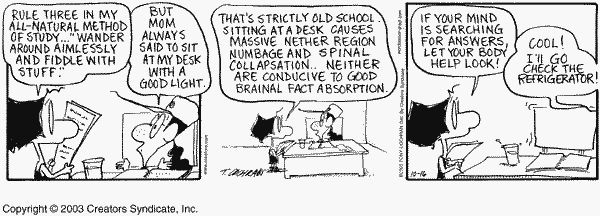
Study hard subjects first. Each night (or day) when studying or doing your
homework, do those subjects first for which you need to be alert and
energetic. Leave the easier, or more fun, subjects to later.
Study in a quiet place, with as few distractions as possible. Do
not listen to music or TV: It is virtually impossible to do two
things at once if one of them is studying.
- Read actively, not passively
-
Read slowly
- Highlight the text in the margin
- Make notes in the margin
- Keep a notebook
- Read literature quickly and passively the first time
- Read before and after class
By 'text', I mean whatever you have to read: It might be a text book, a
work of fiction, a poem, an essay, an article from a journal or magazine,
or even a class handout.
With one major exception, you should not
read passively. That is, don't just read the text straight through
without thinking about what you're reading.

If you read without thinking, I guarantee that
your mind will eventually wander off, your eyes will eventually glaze
over, and you will fall asleep--it's a form of self-hypnosis.
So you must read actively. To use computer jargon, you must turn the
inert medium of text on paper to an interactive medium, in which you have
a "conversation" with the text, as you might if you could be talking to
the author.

The first step in reading actively is to read s-l-o-w-l-y. Here is
an algorithm (i.e., a procedure) for
how to read any text, in any subject, slowly and actively:
WHILE there is a next sentence to read, DO:
BEGIN (* while *)
Read it, SLOWLY;
IF you do not understand it, THEN
BEGIN (* if *)
re-read the previous material, SLOWLY;
re-read the incomprehensible sentence, SLOWLY;
IF you still don't understand it, THEN
ask a fellow student to explain it;
IF you still don't understand it, THEN
ask your Teaching Assistant (TA) to explain it;
IF you still don't understand it, THEN
ask me;
IF you are in an upper-level course & you still don't understand it, THEN
write a paper about it (!)
END (* if *)
END; (* while *)
Since there is no next sentence (because the Boolean test in the
WHILE is false), you've understood the text!
This algorithm has three major advantages:
-
It forces you to actively think about each sentence you read
before you go on to read the next one.
-
It slows you down,
so that you don't read past the point at which you don't understand.
This is especially important in mathematical and scientific subjects.
-
It can help you get help from your teacher, because you can show your
teacher exactly where you got lost. It is always much better to show
your teacher exactly what it is that you don't understand than
it is to
just say that you don't understand the material.
-
Note that it also provides you an opportunity to interact with your
instructors and fellow students!
For more information on slow reading, see:
-
Fletcher, Lancelot R. (1994),
"Slow Reading
Lists (and the Meaning of Slow Reading)"
- Note: If you scroll down about halfway on the above link,
you'll reach the section called "What Do I Mean by "Slow Reading"?".
-
Daly, Robert
(2003),
"Slow
Reading:
Why it Matters, How to Do It, How to Teach It"
There are some other tricks for active reading. One, of course, is to
highlight important or interesting passages. There are several ways to do
this. The worst is to use a yellow highlighting marker (or hot
pink, or whatever color you like). The main problem with this is that you
will tend to find almost every sentence to be important or interesting.
As a consequence, every page will become yellow (or hot pink, or
whatever). Not only does this defeat the purpose of highlighting--because
if everything has been highlighted, then really nothing has
been!--but the pages of your text will become damp, curl up, and be
generally messy.
This technique can have other problems, too:
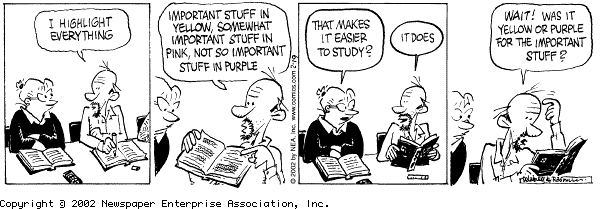
A slightly less messy, but equally useless, technique is to use a pen or
pencil to underline important or interesting passages. I guarantee
that you will wind up underlining every sentence on every page, and you
will have gained nothing.
The technique that I suggest is also susceptible to this problem, but has
a built-in way to overcome it, so that you can
re-read the text, highlighting different passages each
time. The trick is to highlight a passage by drawing a vertical
line in the margin. I like to use the right margin and to make my
line a right square bracket: ]. If you want to make it
clear [exactly
where the highlighted passage begins or ends,] you can use small square
brackets in the text,
as I did in this sentence,
along with the vertical line in the margin.
This way, even if you've
slipped into the error of highlighting (i.e., vertical-lining)
every sentence on every page, at
least you haven't ruined the page. Moreover, when you re-read the text
(note that I said 'when', not 'if' :-), you can then use a different
highlighting technique (e.g., underlining) to highlight more important
passages. Sometimes, I use double brackets in the margin for this second
round of highlighting: ]]
and underlining for a third round. (If you must, you could use yellow
highlighter for a fourth round.)
You should also make notes in the margin of the text (if there's
room, and if the text belongs to you). I like to put
cross-references in the margin; e.g., if a passage on p. 20 reminds me in
some way of a passage on p. 10, I'll write "see p. 10" in the margin on
p. 20, and "see p. 20" in the margin on p. 10. Or I'll put some keyword
in the margin if a passage reminds me of some major idea.
But now suppose that a few months (or a few years) later, you want to find
that interesting passage that related to, say, consciousness; how will you
find it? You could, of course, page through the book till you find it,
but what I like to do is to make an index of my marginal comments; you can
add entries
(e.g., Consciousness: 10, 20)
to the book's index if it already has one,
or use a blank page at the end of the book if it doesn't have an index.
Highlighting has the disadvantage that it
can lead you to highlight everything, and margins have the disadvantage
that they are often too
small for making comments. The best technique for active reading is
to keep a notebook. In addition to (or instead of) highlighting a
passage, copy it--verbatim--into your notebook. Be sure to begin
your notebook with a full
citation to the text for use in a bibliography, and
be sure to write down the page numbers of each passage that you copy.
Then, write down--at length and in detail--your comments on the passage.
(I sometimes like to use a pen for the text and a pencil for my
commentary.)
These notes can then be used later if you write a term paper
or research paper that discusses the material in the text. For that
purpose, it will be useful to number your notes. I find the following
scheme useful: Number each notebook
page with a
Roman numeral
(I, II, etc.), number each quoted
passage (or stand-alone comment) with an Arabic numeral (1, 2, etc.),
and letter (a, b, etc.) each
comment associated with a quoted passage (or stand-alone comment). Then
you can refer to each passage with an identifier (like XIV-7-b, i.e.,
comment b about quotation 7, which comment is located on notebook page
XIV) that will
enable you to find it later. See below.)
Earlier, I said that there was an exception to this
method of slow and active reading. If the text is a work of literature (a
story, novel, play, poem, etc.), it is often best to read it once all the
way through without stopping, just as you would read something for fun,
so that you get to know what it's about and can appreciate it
as a work of literature. (If there's a recording of it, you might find it
helpful to listen to the recording while reading the text; I have
found this especially useful for Shakespeare.)
Then you can use the slow
and active reading techniques for a second (or third, or fourth, or
...) reading when you are studying the text.
Actually, even for non-fiction, it can be useful to read the text
through once, quickly, to get an overview, perhaps making notes if
something strikes you, and then doing the slow and active reading
techniques when you are studying the text.
What about film or video versions? They can be helpful but, in general,
of course are no substitute for reading. The exception here is for plays,
which are intended to be seen, not (just) read. If you do decide to watch
in addition to read, which should you do first? I prefer watching first,
reading afterwards. I have almost always been disappointed by film
adaptations of favorite texts (because they don't match the mental images
that I construct when I read), but I have almost never been disappointed
by a text after watching a film adaptation. Besides, if you watch first
and read later, the adaptation can help you visualize what you're
reading.
Ideally, you should read a text at least twice. Read it (perhaps
quickly) before the class in which it will be discussed, so that
you are familiar with its contents. Then (re-)read it after
class using the slow and active method. If time
permits, you can cut corners by only reading it--slowly
and actively!--after class.
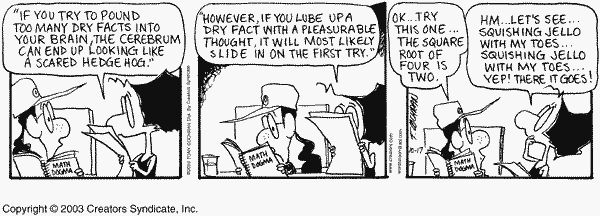
It should go without saying that you should do your homework and do it on
time.
Science and math courses (and some others, such as foreign-language
courses) often require you to do homework exercises or problem sets. I
strongly recommend that you do not simply do the problems and hand
them in. Rather, do them on scrap paper, check them over, and then
copy them neatly. Turn in the neat copy (and, of course, be sure
that your name is on it!).
You may
even want to duplicate your work in case the teacher loses it (unlikely)
or doesn't give it back in time to use it for studying for an exam (this
should only happen in rare circumstances, usually just before an exam
(when the teacher has a lot of things to do),
but it is not unheard of).
And don't just write down answers. Write down the problem and the
complete solution showing how you arrived at your answer.

- Manage your time
- Make a study outline
- Write sample essays & do sample problems
- Make "flash cards"
- Stop studying when you feel confident
Earlier, I discussed managing your time. When
you have exams, time management becomes even more crucial.
Begin studying about 1 week before the exam. Spend at least an hour each
night (or day) studying for the exam in the manner described below. Try to
spend the entire night (and/or day) before the exam studying for it. Of
course, if you have two exams on the same day, you'll have to split the
time in half.
For final exams, try to spend as much time as possible studying. Do not
be tempted, by any free time that you have during exam week, to do anything
other than studying. (If you must take some time to relax, do it
after you've done all your studying for the day.) If you have
E exams and D days to study for them, spend roughly
D/E days studying for each exam. (E.g., if you have 4 exams
and 5 days to study for them, spend a little more than 1 day (1.25 days to
be exact) studying for each exam.)
If you have some free days, then some exams, then some more free days,
then some more exams, etc., plan your studying so that you'll spend
approximately the same amount of time studying for each exam, making sure
that the night (or day) just before an exam is spent studying for it.
E.g., suppose you have 2 free days to study before exam #1, then one more
free day before exams #2 and #3.
Think of each day as having 3 parts: morning, afternoon, and evening.
Let's assume that each exam is in only one of these parts (i.e., it's not
so long that it extends through 2 of them). Then you might divide your
studying time as shown in the chart. Note that you
should not delay studying for exam #3 until after exam #2; start
studying for all exams right away.
| DAY | PART OF DAY | WHAT TO DO |
| Day 1 | morning | study for exam #1 |
| afternoon | study for exam #2 |
| evening | study for exam #3 |
| Day 2 | morning | study for exam #1 |
| afternoon | study for exam #2 or #3 (or both) |
| evening | study for exam #1 |
| Day 3 | morning | study for exam #1 |
| afternoon | take exam #1 |
| evening | study for exam #2 |
| Day 4 | morning | study for exam #3 |
| afternoon | study for exam #2 |
| evening | study for exam #3 |
| Day 5 | morning | study for exam #2 |
| afternoon | take exam #2 |
| evening | study for exam #3 |
| Day 6 | | take exam #3 |
Use your recopied class notes, together with your highlighted text and
notebook, to make an outline of the material. Try to put as much as
possible onto the front sides of only 1 or 2 sheets of paper (like those
plasticized crib sheets that are often sold in college bookstores). Then
do all your studying from these. (You could even combine this outline
with "flash cards".)
For subjects in which you will be expected to write essays, either
"psych out" the teacher and make up some plausible essay questions, or
get copies of old exams that have real essay questions on them. Then
write sample essays.
Although the essay
questions that you find or make up may not be the actual ones on your
exam, you will probably find that much of what you wrote in your sample
essays by way of preparation
for the exam can be recycled for the actual exam. You will then be in the
advantageous position during the exam of not having to create an essay
answer from scratch but being able to merely recall
the main ideas from a
sample that you have already written as part of your studying.
For subjects in which you will have to solve problems or write proofs,
solve lots of sample problems from your text or from other texts
(Schaum's
Outline Series
(McGraw-Hill)
books are usually quite good in this regard).
How will you know if your answers are correct? The best way is to form a
study group of 2 or more fellow students: Solve the same problems and
compare answers. If your answers agree, they're probably correct; if not,
go to your Teaching Assistant (TA) or teacher. As with slow reading,
it's always better when asking for help from a teacher to have a specific
problem or question to ask.
For any subject, you can make a set of "flash cards". But I suggest
using regular 8 1/2" x 11" paper, not index cards. Divide each page in
half, vertically. On the left, write a "question" that requires an
"answer", e.g., the name of a theorem, a term to be defined, the
statement of a theorem, etc. On the right, write the answer, e.g., the
statement of the theorem named on the left, the definition of the term on
the left, the proof of the theorem stated on the left, etc. (This could
even be your study outline.)
Then memorize the questions and answers--but do not
simply recite them by heart. Instead, write down the answers:
Cover the right-hand side (the answers) with a blank sheet of paper, and
write down the answers. When you finish a page, check your work
and repeat writing the answers to the questions you missed
until you get them all correct.
Why
write, and not merely recite? Because you will have to write the
answers on the actual test; get used to writing them now. (Of course, if
it's going to be an oral exam, reciting may be better than writing. Still,
one tends to skip details when reciting, especially if you recite
silently to yourself, but if you write the answers and
have a good memory, then, during an oral exam, you can "read" the
answers with your mind's eye.)
How do you know when you've studied enough? It's
not when you're tired of
studying! And it's not when you've gone through the material
one time! You should stop only
when you get to the point that you feel confident
and ready for whatever will be on the exam--when you're actually eager to
see the exam to find out if you guessed its contents correctly.
First, read the entire exam all the way through.
 For an essay question, do a "mind dump": Write down, on
scrap paper, brief reminders (keywords) of everything that you remember
about the topic of the question. Then
develop an outline of your answer.
Then write the essay. (With luck, much of the essay can be "copied from
memory" from the sample essays you wrote when studying.)
For an essay question, do a "mind dump": Write down, on
scrap paper, brief reminders (keywords) of everything that you remember
about the topic of the question. Then
develop an outline of your answer.
Then write the essay. (With luck, much of the essay can be "copied from
memory" from the sample essays you wrote when studying.)
For an exam with problems to solve or proofs to write, do the easy ones
first.
When you are all done, review your answers carefully.
And, when all of your exams are over, take heed...:-)

- Choose topic carefully
- Do research
- Make an outline
- Write, using your outline
- Edit
-
 Some Interesting Online Articles on Writing
Some Interesting Online Articles on Writing
From
For Better or For
Worse:

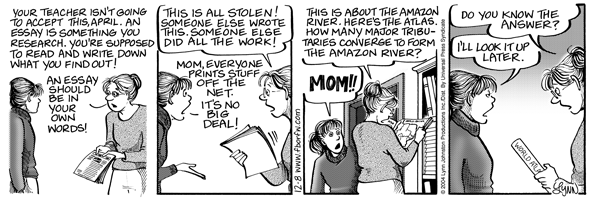
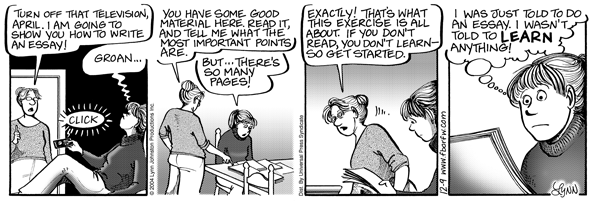
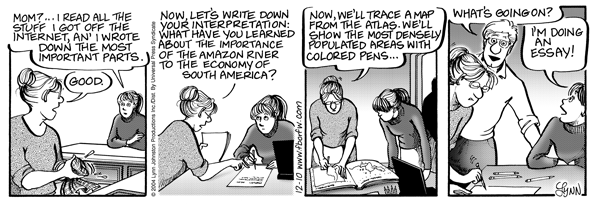
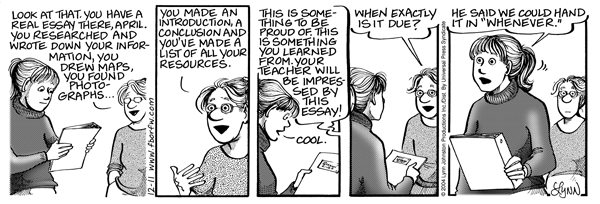
Choose your topic wisely. Avoid the two extremes of a topic that is so
broad or well-known that there are too many sources of information and a
topic that is so narrow or little-known that there is a paucity of
information. If you are having trouble choosing a topic, talk to your
teacher.
Once you have a topic and have found appropriate resource materials,
read
them slowly and actively, and be sure to
keep a notebook.
I won't repeat the details of those suggestions here, with one exception:
Be sure to carefully record your sources and the page numbers of any
quotations, so that you can include them in your final report.
This stage may require several iterations. You should make an
outline and sort your notes into categories that correspond to the main
sections of your outline. But which of these should you do
first? It doesn't matter.
You may have a clear outline in mind, in which case, sorting your notes
will be relatively straightforward (though you may find that some notes
don't quite fit or that some suggest a section that you hadn't initially
thought of). Or you may need to sort your notes
first, to see which ones go together, and then create an outline
based on the categories you discover during the sorting process.
How do you make an outline? The suggestions that follow work for almost
anything you have to write. First, write down a handful of main themes
that you want to discuss (these will be the categories that you sorted
your notes into); describe each using only a few keywords. Decide
in
what order you want to write about them, and then--on a blank piece of
paper--put each at the head of a column, something like this:
intro topic1 topic2 topic3 conclusion
These will be the main sections of your paper. In addition,
you should always have an
introductory section and a conclusion or summary section.
Next, in each column, write down the main ideas that you want to include,
again ordering them and using just a few keywords. These will be your
subsections.
Under each of these, put the identifying numbers
of the items in your
notes that you want to include in each subsection. (You may find that you
will need to repeat this process recursively for subsubsections, etc. If
so, do this when you're ready to write that subsection, not at the
beginning. This kind of process is called "top-down design and stepwise
refinement".)
Once you've got your outline, start writing, using your outline and notes
as a guide. Don't spend too much time editing what you write at this
stage. Just write. (I should note that some people prefer "free
writing", in which you don't spend any time preparing an outline
before you write. If that works for you, go for it.)
By the way, it's always helpful for keeping track of where
you are in your outline, both to you as writer and
to your reader, to give each section and subsection a name, as I have done
in this document.
After you've written your first draft, re-read what you wrote, using the
method of slow and active reading, and revise
(or "edit") what you wrote. Then ask a friend to read it and give you
feedback. Then revise again, and
prepare the final version.
-
Vonnegut, Kurt (1982),
"How to Write with Style"
Abstract:
- Find a subject you care about.
- Do not ramble.
- Keep it simple.
- Have the guts to cut.
- Sound like yourself.
- Say what you mean to say.
- Pity the readers.
-
Gray, Tara (2005),
"Publish and Flourish: Become a Prolific Scholar",
Tomorrow's Professor Mailing List #661

Right about now, you're probably asking yourself whether you really
have to do all of this. It seems like an awful lot of work.
Well, of
course, you don't have to do all of it at once. Try various of these
suggestions to see what works for you. Try some variations that may better
fit your learning style or personal circumstances. But, in the long run,
there's no quick and easy road to studying. It is hard work and
should take a lot of time.
So, do you really have to do all
of this? Yes (or things very much like them)--if you want to
really learn the material (and get good grades).
Finally, for what it's worth, here are some comments from students and
others who
have tried some of these methods:
-
"... this is the way you taught me to study years ago and it finally
paid off last year!" (a college sophomore who went from high-school
grades in the 70s to a 3.00 average in college)
-
"Thank you for the guide. It has some great tips! I'm surprised that I
use some of the techniques myself. (E.g., I abbrev. and cndnse my
notes.) I have one
suggestion, though: when reviewing for a test/exam, only study what you
aren't
familiar with. It reduces studying time and is helpful if you're a last
minute
person like me. :) Well, that may not work for you, but who knows?"
-
"... encourage some study groups! Not 5 in a group, 'cause
that will be a crowd, but study environment is as important as studying
itself; change of environments is sometimes good to make you study
better.
Thank you for your helpful hints, and it does help me to notice some of
my
weaknesses in studying."
-
"I'd like to pass along a bit of technique that worked well for
me in just about all my courses. Thinking about the subject
matter--often catalyzed by discussion with others--before delving into
it was my key to success. After giving it some thought, I wrote out a
series of logical, fundamental questions which I sought to answer that
would clarify the subject matter. You know, make it perspicuous. I
read/listened/watched with those questions in mind, noting as well other
points an author/instructor was attempting to make. If my questions
(which were fundamental to a clear understanding) went unanswered, I
would seek the answers through other written, visual, or aural
materials. Visiting an instructor during office hours or asking the
question in class was often most helpful. Once I had the basics well in
mind, building on them was easy and fun. Studying and learning in this
way also helped me to prepare for exams. Clearly, if I could think of a
question, there was a good chance one writing an exam might think of it
too. The technique is not a panacea for all study-related problems;
however, it does set forth a system to build upon in an individualized way.
I also suggest a
visit to the children's section of the library when revisiting or
attempting to master the basics of certain things. Books written at
that level, though often oversimplified, present ideas and concepts in
a
clear and easily understandable form usually lacking in primers
written
for adults. There's no substitute for laying a good foundation on
which to build additional knowledge." -- Marc L. Ames
-
"I would like to thank you for the effort made doing this guide....
But there is one thing I would like to suggest for ... future
"upgrades" of this
text: I think you have to mention that it is important to be in good
physical condition as well, I mean: sleep 8 hours a day, eat well, ....
What I would like to point is that, in my opinion, it would be good to tell
students that they have to be in their best condition to study/take an
exam/work."
--Diego Fernández Fernández,
E.U.I.T.I.O student (Computer Engineering),
Oviedo (SPAIN).
-
"I would like to thank you very much for the "How to Study" document I
discovered on the net. It is very informative, and it will help me with
my day
to day activities. I only wish I had it while I was in high school!"
--Joseph Di Lillo,
Team Lead--SAP Service Desk.
-
"Thanks so much for the great study guide. I am a high school counselor,
and
we have been teaching a freshmen study skills class for two years....
Your ideas have really inspired me, and there are many
of
the same theories that we have been presenting, but in a new way! Thanks
for
the great tips!"
--Trinity Walsh,
Guidance Counselor,
Elder High School, Cincinnati, OH.

Yes; here are some that looked good to me; many of them have further
links for you to follow:
References
Claxton, Charles S., & Murrell, Patricia H. (1987),
Learning Styles:
Implications for Improving Educational Practices,
ASHE-ERIC Higher
Education Report No. 4 (Washington, DC:
Association for the Study of
Higher Education).
Holland, John L. (1966), The Psychology of Vocational Choice
(Waltham, MA: Ginn & Co.)
Kolb, David A.
(1984),
Experiential
Learning: Experience as the Source of Learning and Development
(Englewood Cliffs, NJ: Prentice-Hall).
Sternberg, Robert J.
(1999),
Thinking Styles
(Cambridge, UK:
Cambridge University Press).
Swerdlow, Joel L. (1999, August),
"The Power
of Writing", National
Geographic 196(2): 110-133, 136.
Copyright © 1999-2005 by
William J. Rapaport
(rapaport@cse.buffalo.edu)
file: howtostudy-2005-10-25.html
























